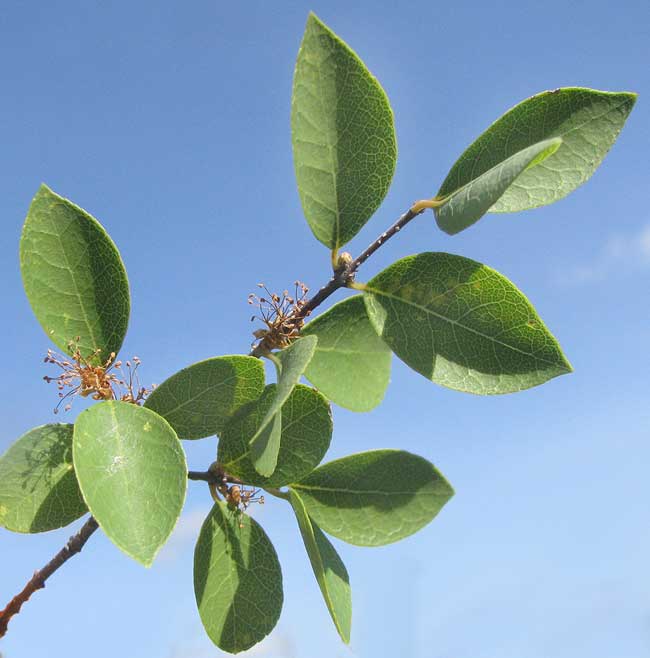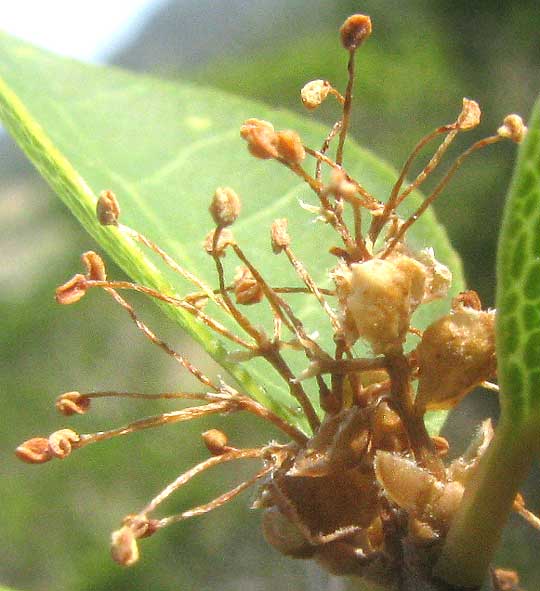Excerpts from Jim Conrad's
Naturalist Newsletter

from the August 11, 2013 Newsletter issued from the Frio Canyon Nature Education Center in the valley of the Dry Frio River in northern Uvalde County, southwestern Texas, on the southern border of the Edwards Plateau; elevation ~1750m (~5750 ft); N29.62°, W99.86°; USA
NETLEAF FORESTIERA
On a certain limestone ledge overlooking the Dry Frio Valley the view is so pretty that even the kind of people who leave trash go there to sit, and kids take the time to deface the smooth stone with carved Bible verses. For a long time I've been waiting for a tree beside the overlook to flower so I could figure out who it is. In mid July its flower buds seemed about ready to burst, so last weekend I hiked up to the overlook hoping for flowers. However, the flowering period already had passed, so all I found were the flowers' brown, withered remains. Above, you can see if you can identify a twig from the tree.
The simple, 1½-inch-long (4cm) leaves arise two per stem node -- they're "opposite" -- so that's an important field mark, since most woody species produce one leaf per node, so they're "alternate." The stiff, straight twig also bears large, white "lenticels," which are warty, window-like structures enabling air to enter the stems. A close-up of some withered flowers is shown below:

I could have kicked myself for missing the fresh flowers, but these dried-up ones still reveal a lot. First, several flowers are shown, not just one with many dried-up stamens. Can you see that in places three or more stamens arise from a common stem, or pedicle? That pedicle and whatever issues from its top comprises a flower, and the ones in our picture bear no female parts, so they're unisexual male flowers. Also, there appears to be no corolla.
A relatively small number of temperate-zone plant families produce woody plants with opposite leaves, and of that group only a fraction develop unisexual flowers. Toying with that insight, eventually I blundered into the family to which our mystery tree belongs: It's the Olive Family, the Oleaceae, best known to North Americans as the home of Lilacs, ash trees, and ornamental Fringetrees. Also, in the swamps of Mississippi, we had the water-loving Swamp-Privet, Forestiera acuminata.
Our cliff-edge tree also is a Forestiera, though obviously it occupies a habitat opposite to that of our swamp species. It's FORESTIERA RETICULATA, in books known as the Netleaf Forestiera.
Netleaf Forestiera is endemic to about a dozen counties of the Edwards Plateau in southwestern Texas, and a bit of arid northern Mexico. Little information is available about it. On the Texas A&M page for the species I read that "It is not a common shrub in Texas, and there is little botanical information available. Like all forestieras, it has male and female flowers on separate plants. They appear in early spring, usually before the leaves, and female plants produce dark blue-black berries that are an important wildlife food source."
That description's assertion that the tree flowers in early spring before leaves develop doesn't coincide at all with our observation. Such early flowering is typical for other Forestieras, including the hairy-stemmed Forestiera pubescens also occurring in our area, so maybe someone just guessed that our species would do the same.
Whatever the case, this is a wonderful find, a rare, poorly known tree and pretty species, just the kind of discovery one always hopes to make.